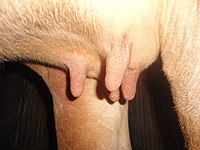
Photo from wikipedia
Previous research demonstrated that nutrition during the far-off (early) dry period may be as important to transition success as nutrition during the close-up dry period. Our objectives were to determine… Click to show full abstract
Previous research demonstrated that nutrition during the far-off (early) dry period may be as important to transition success as nutrition during the close-up dry period. Our objectives were to determine if a low-energy, high-fiber diet fed throughout the dry period improved metabolic status and production of dairy cows compared with a higher-energy diet or a 2-diet system, and to compare responses of cows and heifers to those diets. Holstein cows (n = 25 with 10 primiparous per treatment) were assigned to each of 3 diets at 60 d before expected calving. Treatment LO [40.5% wheat straw; 5.6 MJ of net energy for lactation (NEL)/kg of DM] was designed to meet but not exceed National Research Council recommendations for ad libitum intake from dry-off until calving. Treatment HI was a high-energy diet (6.7 MJ of NEL/kg of DM) fed for ad libitum intake from dry-off until calving. For the LO+HI treatment, the LO diet was fed ad libitum from dry-off until 21 d before expected calving, followed by the HI diet until parturition. After parturition all cows were fed a lactation diet (7.0 MJ of NEL/kg of DM) through 63 d postpartum. Dry matter intake and body weight were greater for HI cows prepartum, but not postpartum. When LO+HI cows were switched to the HI diet, their dry matter intake increased to match that of HI cows. Cows fed HI had greater gain of body condition before calving but lost more postpartum. Energy balance postpartum was higher for LO cows than for HI cows. Milk production, protein content, and protein yield did not differ among diets. Milk fat content and yield were highest for HI cows, lowest for LO, and intermediate for LO+HI cows. The HI cows had lower serum nonesterified fatty acids prepartum than either LO or LO+HI, but greater concentrations postpartum. Serum β-hydroxybutyrate did not differ prepartum, but was greater for HI than for LO or LO+HI postpartum. Serum glucose and insulin were lower for LO than HI and LO+HI prepartum; insulin was lower for LO and HI than for LO+HI postpartum. The LO cows had lower liver total lipid concentration postpartum than the HI cows and LO+HI cows. Primiparous cows generally responded to diets the same as multiparous cows. The LO+HI feeding strategy provided no benefit over the LO diet. Moreover, the high-energy diet, even when fed for only 19 d before calving in the LO+HI group, resulted in increased serum β-hydroxybutyrate and liver total lipid concentrations compared with LO.
Journal Title: Journal of dairy science
Year Published: 2020
Link to full text (if available)
Share on Social Media: Sign Up to like & get
recommendations!